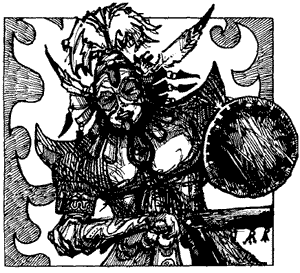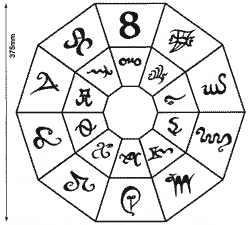The Eye of All-Seeing Wonder
Issue Six | Winter 1996
In the House of the Rising Thún’ru
Orun hi Kharsan and Ian Marsh reveal the secrets of the Black Art of Astrology
“Triumph to Lord Thúmis on the feast day of Lord Karakán. The hour of victory will come when Lady Avánthe in her rage refills the River of Bones. So the gods have decreed.”
Whether that forecast ever comes true will become clear shortly: it is one I made during the course of a game in the guise of Orun hi Kharsan of the Hall of Stone, deputy head of astrology in the Temple of Thúmis at Chene Ho. It is one of many that have added colour to the game run by Patrick Brady, and if it follows the trend it will, rather spookily, come true.
All the forecasts use one of Orun hi Kharsan’s works of devotion: a hand-crafted fortune-telling set. Doubtless the actual set owned by Orun is a marvel to behold, but the set used in the game merely comprises a sheet of coloured corrugated cardboard and seven painted Go stones.
The system relies entirely on the planetary influences possible on Tékumel, which in essence makes it far simpler than Earth’s zodiac. It should also be noted that the system has no basis in mysticism: it is just something I made up, although my interest in the Tarot may have had some influence. Most important of all, Orun’s system works because the people involved in the game have faith in it.

Set in Stone
The set comprises seven stones, representing all the planetary influences: yellow Tuléng (Hnálla), brown ülétl (Sárku), scarlet Riruchél (Karakán), blue Shíchel (Avánthe), purple Zirúna (Hrü’ü), green Gayél (Dlamélish) and orange Káshi (Vimuhla). These are all the active agents: it is their influence on the twenty-one houses on the board that tells of the future. I just took seven stones from my Go set (a game probably more fiendish than Den-den) and painted them with acrylics; seven different coloured dice would probably work just as well.
The board itself represents Tékumel. On it, around the central house known as the Clanhouse, are arrayed the houses of all the 20 deities of Pavár’s pantheon. Gods are paired with their cohorts, and each pair faces its opposite across the Clanhouse. The order around the board is arbitrary, but Orun chooses to position Lord Hnálla at the top and Lord Hrü’ü at the bottom. Going round the board, the pairs alternate between stability and change. The Clanhouse typically represents the caster’s own clan, but also represents the subject of the question. Direct influences on the Clanhouse are more important than whatever else the board reveals.
To make a forecast, the caster holds the seven stones in one hand and thinks about the question he wants to ask. It is best done in a quiet room with no disturbances, although if the players remain quiet enough it is possible to accomplish a forecast in everyone’s presence. When the moment is right, the caster drops the stones on the board -- the height at which they are dropped depends on experience and the material used to make the board. Stones which land across one of the lines or beyond the houses of the gods have fallen into the void and are removed. Only those stones that are left clearly in one of the twenty-one houses are used in a reading. In practice, I only remove stones whose centres are clearly over a void line; the others fall into whichever house contains most of the stone.
At this point it is all a question of interpretation and experience. I find the notes on the gods in the brown book, coupled with the astronomical data in the blue book, provide enough help to make sense of the stones.
Open to Interpretation
The descriptions of the twenty deities given in the brown book are helpful as they give some idea of the properties of each house and each stone. Simply read, Tuléng means success or strength, ülétl represents death or disaster, Riruchél represents heroes (typically the player characters), Shíchel is life, water or a clangirl, Zirúna is change or negation, Gayél is deception or an Aridáni, and Káshi represents fire or destruction.
Four stones can also indicate the timing of an event.
Tuléng’s meaning is clear: the position of the sun in the sky is indicated by the position of the stone on the board. Be careful not to confuse the timing element with expected success! Remember what the subject is. An eclipse might be suggested by Tuléng in Sárku; solar flares by Tuléng in Hrü’ü.
Shíchel can represent the state of the rivers. Shíchel in Avánthe means the river is at its highest; if Káshi were in Avánthe as well that could mean a flood. Sárku in Avánthe might mean the river is at its lowest point; if Káshi were in Avánthe as well, then this time there could be a drought. Shíchel can also mean at a time of rain -- monsoons, thunderstorms or light showers depending on the influences of other stones.
Gayél and Káshi indicate the state of the moons. Very good for descriptive purposes and for discovering how much light there will be on a night mission. Again, position on the board determines whether they are full (in Hnálla) or obscured (in Hrü’ü). Gayél in Vimuhla might mean at the moment when Lady Dlamélish kisses Lord Vimuhla in the heavens; it might also mean that someone is going to play an awful trick on a Vimuhla worshipper (take that, you damn Vríddi).
And Now the Hard Part
The cast which led to the interpretation at the start of this article was very simple:
Tuléng in Thúmis; and
Shíchel and ülétl in Karakán.
This rather bald result can be dressed up. As Orun might say: ’The radiant light of Lord Hnálla shines upon the House of Thúmis while Avánthe struggles with Sárku in the realms of Heroes.’ Analysing it, however, requires some thought.
At this point the referee can get the player to roll against any astrology skill his character has. The referee can also go away and think about what has been rolled and work out how it ties in with the plot of an adventure -- or whether it suggests any sub-plots. That way an accurate forecast can be made to come true; an inaccurate forecast can also lead players astray. After some experience of the system, an astrologer player can suggest his own interpretations, and if he has some confidence in the character’s ability in astrology, can make bold predictions of the future.
Orun’s question concerned a plan of action against the Twisted Mark, a bunch of low-lifes in the slums of Chene Ho, and was simply: ’If Orun fights, what will happen to him? As he happens to be rather a talented astrologer, you can imagine he rose from his board with a suitably smug grin.
So why is Orun so confident? Well, for a start the forecast was a follow-up to an earlier question about whether a particularly cunning plan he had devised would work. This had already produced Shíchel and ülétl in Avánthe, which I interpreted as the time when the river was at its lowest point yet also would be at its fullest -- it was just a question of how this could be achieved. When both planets fell into Karakán in the second reading, I had a clearer idea of the exact day -- and by then knew how the river could be both empty and full. Patrick very kindly offered the information that there would be a Karakán festival within two days of the River of Bones being at its lowest point. As rivers are not entirely predictable, that’s close enough. The river will also be full because on that day there will be a terrible thunderstorm. So, Orun hi Kharsan knows when to act, and as a devoted sixth circle priest of Lord Thúmis, he is more than pleased to have Hnálla’s blessing. That’s enough to generate a huge aura of smugness.
Further Readings
Another taster is in order. Feel free to disagree with it -- it is, after all, only the humble interpretation of a young priest of Thúmis. But then, Orun hi Kharsan has yet to be wrong...
How successful will my forthcoming marriage be?
Stones: Shíchel and Gayél in the Clanhouse, Zirúna in Drá, Káshi in Chiténg.
Announcement: Dlamélish and Avánthe take residence in the clanhouse, chaos is annulled; the Maker of Thunders embraces his cohort, the Lord of the Spouting Flame.
Forecast: A woman of beauty joins the clanhouse -- she is independent and strong-willed, yet brings order and stability. A period of change ends as two sparks are fanned into a fiery passion. This marriage will succeed and it will be exciting. The clan will profit from it.
Interpretation: Gayél implies an Aridáni aspect, Avánthe the good clan girl. It is appropriate that both stones should fall in the Clanhouse given that the question is about marriage (don’t ask me why the stones do it). The male subject’s life has been through a period of turmoil, but because Zirúna has fallen into Drá’s realm, the implication is that this chaos is about to end. Vimuhla in Chiténg represents the melding of two like minds; the strength of the cohort is reinforced by the presence of his lord. As all this seems to bode well, it’s safe to say the clan will profit -- a touch of embroidery to please the clan elders doesn’t hurt!
How to build your own board
Because the board is constructed according to how I thought it should look, the precise measurements are a little odd. It measures 375mm across (or about 396mm along the void lines). The Clanhouse is 65mm across, the cohorts (inner ring) are each 70mm across and the gods (outer ring) are each 85mm across.
The easiest way of constructing the board is to photocopy the above diagram and enlarge it to whatever size you want. You may have to split it over several sheets of paper and reassemble them. It will eventually be available as a Postscript file on my Web site.

Orun hi Kharsan’s Fortune-Telling Board
[click to enlarge]
The symbols are taken direct from the source books, but to avoid doubt the areas are as follows:
Outer ring, reading clockwise from the top:
Hnálla, Ksárul, Avánthe, Sárku, Karakán, Hrü’ü, Thúmis, Dlamélish, Belkhánu, and Vimühla.
Inner ring, reading clockwise from the top:
Drá, Grugánu, Dilinála, Durritlámish, Chegárra, Wuru, Keténgku, Hriháyal, Qón and Chiténg.
Centre: The Clanhouse.
I cut each section out of quality, lightly tinted paper, mounted them on the side of a large cardboard box, and then drew the void lines over the joins in black felt pen. Each section was then edged with the prime colour appropriate to the god (for example, green for Dlamélish and Hriháyal). The corrugated card tends to soften the bounce of the stones I use and stops all of them falling off the edge—after all, you need something on the board to make a reading. Unless, of course, the gods are being particularly unkind …
